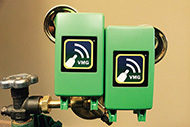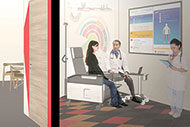Work on the $438 million University of Texas Medical Branch (UTMB) Health Jennie Sealy Hospital in Galveston nears completion in time for a scheduled spring opening.
The state-of-the-art facility will offer a full gamut of advanced health care services in a setting where patient clinical needs and comfort are high priorities. Each of the 310 patient rooms is designed to provide a team-based, family-centered approach to care.
Evidence-based design principles, featuring abundant natural light, were applied throughout the new hospital. Many of the patient rooms in the 12-story, 765,000-square-foot facility offer views of either the Gulf of Mexico or Galveston Bay.
Considering the meticulous care that went into providing the best health care services in a facility designed to be soothing and healing, it’s no surprise that the same level of attention went into the infrastructure.
Curtis Adkerson, CHFM, CHC, building automation system (BAS) customer service manager at UTMB, designed a unique control strategy for the new hospital’s isolation and operating rooms (ORs) to comply with pressurization, temperature and humidity requirements of the Joint Commission, Oak Brook Terrace, Ill.
The Joint Commission’s Environment of Care standard EC.02.05.01 EP15 is one of the most commonly cited for noncompliance during the hospital accreditation surveys it conducts, according to the Joint Commission.
The unique strategy designed for the new hospital adds additional reliability to the BAS to maintain compliance with the standard.
“The Joint Commission is looking for staff to have visibility into the room conditions in order to acknowledge when conditions present a risk to the patient,” says Stuart Feilden, EIT, CHC, health care account manager, Siemens Building Technologies Division, Houston. “So we’re looking forward to the Joint Commission’s feedback on this unique system configuration.”
Siemens, as a subcontractor to the construction project, implemented the system design, which utilized its Apogee BAS and hardware. Working with facility staff, Siemens engineered the system and configured the touch-screen graphics that allow nurses, doctors and maintenance staff to interact with the hospital’s control room, if necessary.
Adkerson says the touch-screen graphics are one of the major benefits of the system. The unitary control system Adkerson designed utilizes a programmable terminal box controller that controls both supply and exhaust air terminals without relying on BAS network connectivity.
During a power outage, such as a generator test, the controller and touchscreens continue to operate because both are backed up by an uninterruptible power supply. This allows the room to continue to maintain control settings throughout an outage, Adkerson says.
Identical touchscreens are installed inside and outside each OR so that clinical staff can respond to a system alarm and notify the facility control room that the system serving the space is not meeting correct parameters. Those include temperature, humidity, supply air changes per hour and differential pressure.
“Everything that’s compliance-driven is on that screen,” Adkerson says. According to Adkerson, the technology is important because OR staff need to know if the room is functioning properly and also need to have the information available to communicate a possible issue. The system allows immediate notification to facility staff, which reduces response time, he adds. “We’re utilizing the technology that’s available to provide the most reliable and safest system we can,” Adkerson says.
“We’re building a new hospital. I want to take advantage of the best technology possible.”
HOSPITAL // Jennie Sealy Hospital
NEED // Building automation system that meets the Joint Commission Environment of Care standard for critical care areas
SOLUTION // Siemens Apogee building automation system and control strategy This image shows information that is viewable on the touchscreen of the building automation system serving the operating rooms at Jennie Sealy Hospital, enabling staff to know if conditions in the space require adjustment.





